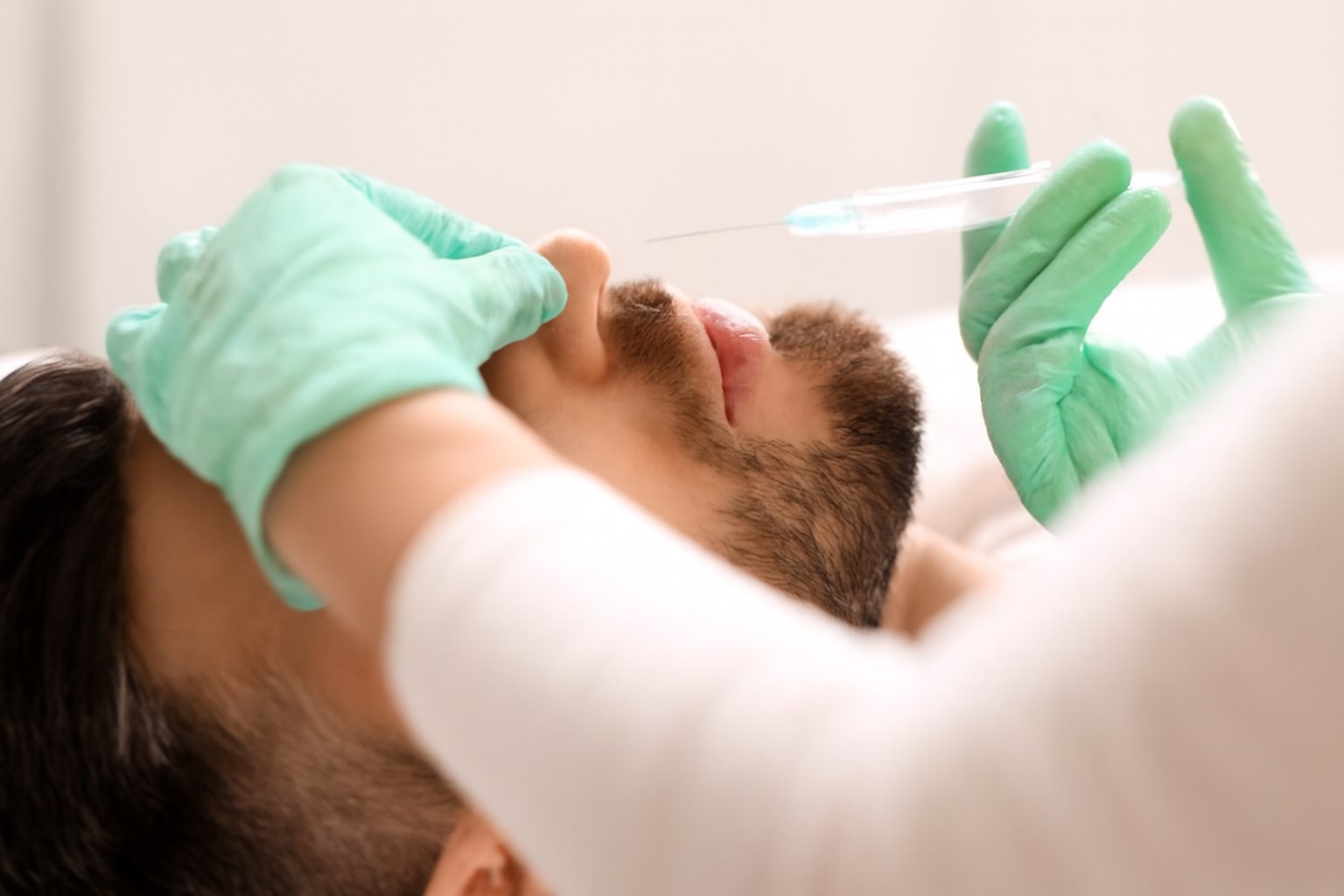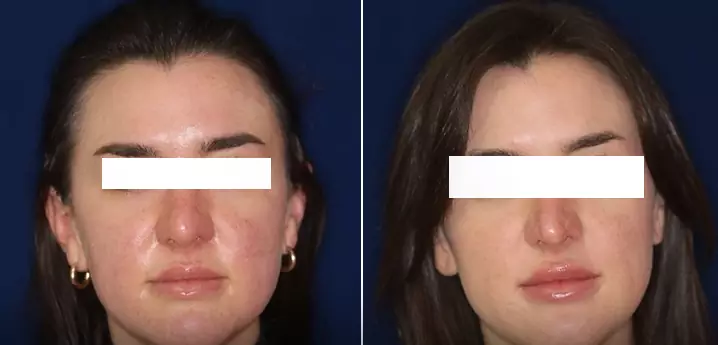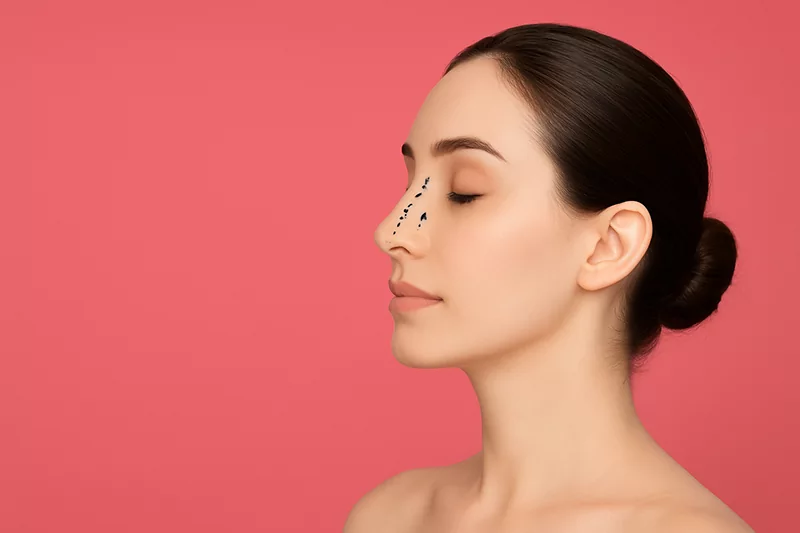Why is Cortisone Injection Done After Nose Surgery? + Side Effects
Nasal Swelling After Rhinoplasty (Cosmetic Nose Surgery)
Nasal swelling after rhinoplasty (cosmetic nose surgery) is a relatively common side effect, which cosmetic surgeons address by injecting corticosteroid medications, also known as cortisone. Corticosteroids are a class of anti-inflammatory drugs that reduce inflammation in the body by producing specific chemicals. Doctors usually wait a few months after the nose surgery before injecting cortisone to ensure the nasal tissues do not change shape abnormally. If you have recently undergone cosmetic nose surgery and are in the recovery phase, stay with us in the following article from Dr. Fakhriye’s magazine, as we intend to discuss the impact of cortisone injections after rhinoplasty in more detail.
Reason for Cortisone Injection After Rhinoplasty
Cortisone injection after rhinoplasty is performed to reduce severe inflammation, persistent swelling, and to prevent the formation of scar tissue and excess tissue. After nasal surgery, especially for individuals who have undergone “fleshy nose” rhinoplasty, the process of reducing swelling may be slower than usual due to the thick skin of the nose. This is why the surgeon injects cortisone.
Corticosteroids, commonly referred to as cortisone, have anti-inflammatory properties and prevent complications such as hardening of the nasal tissue, long-term swelling, and the formation of abnormal bumps on the nose. This injection should be done at the discretion of the cosmetic surgeon because injecting it in the proper location and with the correct dosage is effective in preventing complications such as thinning of the nasal skin and the formation of indentations.
Uses of Cortisone Injection After Rhinoplasty
Cortisone medication is helpful in reducing inflammation and nasal congestion. When this medication is injected under the direct prescription of a specialist, it helps reduce complications and increases effectiveness. In the following, we will discuss the impact of cortisone injections after rhinoplasty.
1.Cortisone Injection After Nasal Surgery to Reduce Nasal Swelling
If you look at the before and after photos of cortisone injection into the nose, you will notice that this injection is effective in reducing inflammation and swelling of the nose. Inflammation and swelling after rhinoplasty are natural bodily reactions that typically last for a few months. If this swelling persists and lasts for a long period, it negatively impacts the final appearance of the nose. In such cases, the specialist injects cortisone into the inflamed and swollen area of the nose due to its anti-inflammatory properties. In fact, it can be said that cortisone, like dexamethasone injections, is highly effective for nasal swelling and can speed up the healing process after rhinoplasty.
2.Preventing Scar Formation with Cortisone Injection After Rhinoplasty
It doesn’t matter whether you’ve had a natural or a more artistic rhinoplasty, the formation of scar tissue is another common side effect after rhinoplasty that some individuals experience. Scar tissue usually forms in people with thicker soft tissues, between cartilage, bone, and skin. This condition destroys the delicate appearance of the nose and causes it to deform. In such cases, the cosmetic surgeon can help eliminate abnormal scarring, tissue hardness, accelerate healing, and achieve better aesthetic results by injecting cortisone into the nose.
3.Cortisone Injection After Nasal Surgery for Nasal Shape Alterations
Swelling is one of the common side effects after rhinoplasty. Generally, individuals who undergo rhinoplasty, depending on the type of surgery (such as closed or open rhinoplasty), experience varying degrees of swelling in this area. Typically, swelling and inflammation of the nose subside within two weeks. However, if after a few weeks, some areas of the nose remain swollen, the doctor may inject cortisone to help improve the shape of the nose. Sometimes, the cosmetic surgeon may inject cortisone into the nose even after a year to treat persistent, long-term swelling.
Best Time for Cortisone Injection into the Nose
Cortisone injection after rhinoplasty is usually performed a few months after the surgery. However, some surgeons believe that to prevent the progression of scar tissue, it is better to inject cortisone one to two months after nasal surgery. On the other hand, other surgeons believe that during the first two months after rhinoplasty, much of the nasal swelling naturally subsides, so it is better to wait three to four months before injecting cortisone after rhinoplasty.
During this period, the initial healing process occurs, the nose assumes its new form, and any abnormal and persistent swelling is identified. Additionally, due to the potency of cortisone, injecting it three to four months after rhinoplasty can help address the formed scar tissue.
How Long After Cortisone Injection Will Nasal Swelling Subside?
The reduction of nasal swelling after semi-fantasy rhinoplasty or other types depends on the extent of swelling, skin type, and the patient’s condition. Some individuals achieve the desired results with just one cortisone injection, while others may need multiple injections at specific intervals. However, it can be said that approximately one week after the cortisone injection, the swelling of the nose will significantly reduce. After the necessary examinations by the doctor, the next injection will be scheduled if needed.
Benefits of Cortisone Injection After Rhinoplasty
Some of the key benefits of cortisone injection after various types of cosmetic nose surgeries, such as bony or fleshy rhinoplasty, include:
-
Accelerating the healing process of inflammation and swelling in the nose
-
Preventing the formation of fibrosis (excess tissue)
-
Preventing and treating abnormal scars
-
Improving the final shape of the nose
-
Helping resolve breathing issues caused by inflammation and swelling in the nose
-
A minimally invasive method and a suitable alternative to corrective surgery
How Many Times is Cortisone Injected into the Nose?
The number of cortisone injections after rhinoplasty depends on the condition of the nose, skin type, the severity of swelling or scarring, and the surgeon’s opinion. The doctor may perform the first injection three to six weeks after nasal surgery to reduce swelling. If necessary, subsequent injections should be performed at four to six-week intervals. In cases where the patient requires multiple doses, usually one to three injections with specific intervals are sufficient. However, in specific cases, such as very fleshy noses with persistent swelling, more frequent injections may be necessary. Remember that the number of injections, timing for receiving the medication, and all injections should be determined by the cosmetic surgeon.
Where is the Cortisone Injection Administered on the Nose?
The most common areas of the nose that swell after rhinoplasty are the supratip region (the area above the tip of the nose) and the tip of the nose itself. This area consists of thicker skin, and since the thicker the skin of the nose, the greater the amount of swelling after the surgery, it is more prone to swelling.
What to Do After Cortisone Injection Into the Nose?
Although cortisone injection into the nose after rhinoplasty is simple and minimally invasive, it requires careful attention and care for optimal effectiveness. Some of the most important post-injection care instructions include the following:
-
Rest for up to 2 days after the cortisone injection and avoid lifting heavy objects.
-
Avoid intense physical activities or exercise for at least one month.
-
Do not touch your nose or apply pressure to the injection site.
-
Apply a cold compress to the nose for 2 days after the cortisone injection to prevent inflammation and swelling.
-
To prevent infection after surgery and cortisone injection or reduce pain, take antibiotics and pain medications as prescribed by your doctor on time.
-
How you sleep after nose surgery and cortisone injection is very important. It is generally recommended to sleep on your back for a few weeks and place an extra pillow under your head.
-
Do not use creams or topical medications without consulting your doctor.
-
To prevent coughing after rhinoplasty and cortisone injection into the nose, avoid consuming allergy-causing and spicy foods.
Maintaining a proper diet before rhinoplasty, such as avoiding inflammatory foods and consuming foods rich in vitamin C, helps reduce swelling after surgery and may even reduce the need for cortisone injections. If you are wondering “what to eat before nose surgery,” you can read the related article in Dr. Fakhriya’s. You can also find useful information on Dr. Fakhriya’s website about “what to eat after nose surgery.”
Applying Tape After Cortisone Injection into the Nose
One of the most frequently asked questions after cortisone injection into the nose is whether we should still apply tape on the nose. The answer is that cortisone injection after nose surgery helps reduce swelling and improve the shape of the nose. However, many doctors consider applying tape after the cortisone injection as a complementary part of the treatment and recommend using it for one to two weeks after the injection. Of course, this should be done under the doctor’s direct recommendation and with gentle pressure to avoid any reverse effects.
What Are the Side Effects of Cortisone Injection After Rhinoplasty?
Just as bruising and swelling around the eyes are common side effects after rhinoplasty, some individuals may experience varying degrees of nasal swelling after the procedure. Cortisone injection after rhinoplasty significantly reduces nasal swelling and inflammation, but if it is not injected into the correct area, at the proper dose, or by a skilled doctor, it can cause side effects such as:
-
Thinning of the nasal skin
-
Color changes in the area where cortisone was injected into the nose
-
Pain, discomfort, and swelling of the nose
-
Formation of lighter skin patches (hypopigmentation)
-
Infection (in rare cases)
-
Increased blood sugar levels
Some individuals, after receiving a cortisone injection into the nose, may mistakenly think they have broken their nose when they notice swelling or unevenness on the surface of the nose. In such cases, being aware of nasal fracture symptoms, such as severe pain and widespread bruising, helps to differentiate between a serious issue and normal post-surgery swelling.
Nasal Indentation After Cortisone Injection
Nasal indentations after cortisone injection are a relatively rare side effect of this method, caused by the negative impact of cortisone on the skin tissues and the cartilage structure of the nose. If cortisone is not injected into the correct area of the nose, it causes changes in the underlying tissue and results in thinning of the skin. As a result, indentations and unevenness appear on the nose. However, it is important to note that this type of unevenness is on the surface of the nose and differs from nasal deviation or crookedness. If you’re curious about what nasal deviation is, you can read the related article on Dr. Fakhriya’s website.
It is important to mention that cortisone injections after rhinoplasty should be performed by a specialist after thoroughly examining the skin and structure of the nose. This issue typically arises when the appropriate dose of medication is not administered or when the medication is not evenly distributed in the desired area. It may also occur in individuals with very thin nasal skin or bony noses. The nasal indentation may resolve over time, but if it is severe, corrective treatments such as filler or fat injections may be needed.
Guide to Seeing a Doctor
Cortisone injection after rhinoplasty is an effective method for reducing persistent nasal swelling and preventing the formation of scar tissue. This method is particularly effective for individuals with thicker skin in the nasal area, helping prevent issues such as tissue hardening and the development of prominent scars. Despite the many benefits of cortisone injection after rhinoplasty, careful attention to the timing of the injection, the correct dosage, and the proper location for injection significantly impacts the outcome. Therefore, it is highly recommended to have it performed by a specialist or cosmetic surgeon.
In this article from Dr. Fakhriya’s magazine, we discussed cortisone injections, the steps to reduce nasal swelling after surgery, and its other uses. We also reviewed the importance of following post-injection care instructions. If you have more questions about this, you can visit Dr. Fakhriya’s website and consult with top specialists, including online ENT doctors or online cosmetic surgeons. Additionally, Dr. Fakhriya’s clinic has made it possible for you to request an in-person consultation appointment through the clinic’s ear, nose, and throat system.





